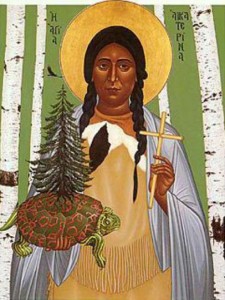Native American recognize the Beatified Lily of the Mohawk

Roman Catholic faithful — from California to New York and Arizona and from Canada to Mexico — have been flooding into Rome to witness Kateri Tekakwitha’s canonization by Pope Benedict XVI on Sunday. She will join six other beatified Catholics being lifted into sainthood.
In preparation for Sunday’s ceremony in Vatican City, immense tapestries bearing the images of the new saints have been hung from St. Peter’s Basilica. The name Tekakwitha — she was simply Kateri before — was a result of her badly damaged eyesight that accompanied her smallpox scars. It means “she who bumps into things.” Now she is often referred to as the Lily of the Mohawks.
She had been introduced to Catholicism by Algonquin mother and a Mohawk father and held fast to her faith when she and her foster family moved to the north riverbank after their village was destroyed in war by the invading English. The sainted Indian girl, Kateri-Catherine Tegakwitha. In the same year a Sulpician mission was established among some Christian Iroquois, chiefly Cayuga, Quinté Bay at Lake Ontario; but after a few years it was absorbed by the Iroquois mission of The Mountain, established in 1676 on the island of Montreal by the sulpicians. This mission was transferred in 1704 to the Sault au Recollet, north of Montreal, and in 1720 to its present site at Lake of Two Mountains, on the island of Montreal, with a number of Algonquin sharing the village.
With the withdrawal of the greater part of the Christian element to Canada and the renewal of war in 1687 all missionary effort in the Iroquois territory was finally abandoned, although Father Milet continued with the Oneida until 1694. In the war of 1687-99 Catholic Iroquois from the Canada missions fought beside the French against their heathen kindred of the confederacy. As a result, Tekakwitha studied her faith in secret until she was baptized at 18 near present-day Fonda, N.Y. Over time, Tekakwitha was ridiculed for her beliefs and she fled to Canada.
After she died at age 23, a priest reported what is regarded as a miracle — the scars on her face vanished and her skin took on a youthful appearance. Villagers reported seeing visions of her reassuring them she was going to heaven, and for years afterward, the earth she touched was used to treat people’s ills. She had settled at the Mission of St. Francis Xavier with a group of Christian Indians in Quebec.
“We’ve been praying every morning for this for 12 years,” said Msgr. Michael Slattery of St. Kateri Tekakwitha Catholic Church in Santa Clarita.
“It was really ecstatic when the final miracle had been approved by the Vatican for canonization,” the monsignor said Saturday. “She doesn’t just belong to any particular group. Her attributes and her virtue and dedication … she’s a great person for people to imitate.”
For some Native Americans, Tekakwitha’s canonization carries a significance that goes beyond her Catholic faith.
Tekakwitha is known as the patroness of ecology and nature, and her sainthood can also be viewed as a celebration of Native American spiritual traditions, said Juana Majel Dixon of the National Congress of American Indians.
The Blessed Kateri Tekakwitha, who died at age 24, will be canonized Sunday, Oct. 28, 12, by Pope Benedict XVI.
“It is a significant event for many of the Native Americans who are Catholics because they see it as and affirmation of their faith, that this young Mohawk girl finally is being recognized as a saint,” said the Rev. Stephen Barnufsky, pastor of San Xavier Mission south of Tucson.
Orphaned at age 4 after her parents and brother died of smallpox, she went to live with relatives. The virus left her weak and damaged her vision.
In 1670, St. Peter’s Mission was established in Caughnawaga, now Fonda, New York. Tekakwitha met Father James de Lamberville four years later and asked to be baptized. The remainder of her life was devoted to teaching prayers to children and helping the sick and aged.
“She’s the first Native American saint to be canonized and it’s exciting because she’s one of us,” said Art Bailey, who will witness the ceremony in Rome with seven other Tohono O’odham Nation members.
Navajo flutist Vince Redhouse, who recently moved from Tucson to Washington State, will perform at the ceremony in Rome with three of his college-bound Navajo students. The piece, “Sonata for Four Native Flutes,” was composed by local artist Mike Levy.





